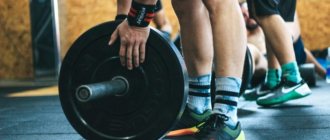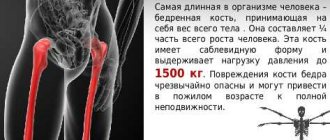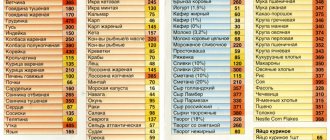It is believed that the ideal weight is the one you had at 18 years old. It is advisable to keep it for life. But if you have moved away from the ideal over the past 15–20 or more years, you should not strive to return to it at any cost. After all, every 10 years of life, the body’s energy expenditure decreases by about 10%. Accordingly, every 10 years we add approximately 10% (5–7 kg): first from that very ideal weight, later from the one we have. And you should lose fat carefully, focusing on the same 10%, only within a year. In addition, it is better to no longer strive for an eighteen-year-old weight, but to calculate your new ideal using one of the medical formulas.
Brocca's formula
Ideal weight for men = (height in centimeters – 100) · 1.15.
Ideal weight for women = (height in centimeters – 110) · 1.15.
Example: Ideal weight for a woman 170 cm tall = (170 – 110) · 1.15 = 69 kg.
Surely this formula will remind many of the old “height minus 100” for men and “height minus 110” for women. This is truly an improved version of that old formula. The fact is that the previous version required everyone to be fitness models and did not take into account either age or body type. Therefore, neither people with heavy bones and large muscles, nor women with clearly defined hips and breasts could fit into it at all. Therefore, scientists have reworked the old Brocca formula, and in its current form it looks quite realistic.
Section Six: Improving Training Effectiveness
This section provides recommendations for increasing the effectiveness of your training.
Choosing the right type of training is half the success in achieving your goals.
Recommendations for duration and number of workouts are provided based on an assessment of your current physique. Remember, every body is individual. If you have chronic diseases, take into account the recommendations from the “Diseases” section, as well as the recommendations of your doctor!
Maximum heart rate (HR bpm) – the maximum allowable heart rate during physical activity. The highest heart rate value at maximum physical effort.
Take a body composition analysis
Lorenz's dream
A woman’s ideal weight = (height in centimeters – 100) – (height in centimeters – 150) / 2.
Example: Ideal weight for a woman 165 cm tall = (165 – 100) – (165 – 150) / 2 = 65 – 15/2 = 57.5. Ideal weight – 57.5 kg!
Please note that this formula was developed only for women and is in no way suitable for the stronger sex. At first glance, it is too demanding on weight compared to the improved Brocca formula and rather indicates exactly the ideal weight when you were eighteen years old. However, it is completely consistent with the body mass index (BMI), so it is quite possible to use it. If you are upset by the proposed numbers, then just forget about it and use another formula. By the way, it still won’t suit women taller than 175 cm.
How it works?
The algorithm is based on mathematical calculations of anthropometric measurements. Formulas developed by scientists and approved by WHO are used. Experts in their field – trainers and nutritionists – took part in the development of the service.
To carry out the analysis, you will need a measuring tape (or a thread and a ruler) and the most ordinary scales. Read more about how to do a body composition analysis online here.
Egorov-Levitsky table
This method does not have a single author, and no formulas are required either. You just need to find out your height, weigh yourself and compare the data with the table. Please note that this is not the ideal weight, but the maximum!
Maximum permissible body weight
| Height, cm | 20–29 years old | 30–39 years old | 40–49 years old | 50–59 years old | 60–69 years old | |||||
| husband. | wives | husband. | wives | husband. | wives | husband. | wives | husband. | wives | |
| 148 | 50,8 | 48,4 | 55 | 52,3 | 56,6 | 54,7 | 56 | 53,2 | 53,9 | 52,2 |
| 150 | 51,3 | 48,9 | 56,7 | 53,9 | 58,1 | 56,5 | 58 | 55,7 | 57,3 | 54,8 |
| 152 | 51,3 | 51 | 58,7 | 55 | 61,5 | 59,5 | 61,1 | 57,6 | 60,3 | 55,9 |
| 154 | 55,3 | 53 | 61,6 | 59,1 | 64,5 | 62,4 | 63,8 | 60,2 | 61,9 | 59 |
| 156 | 58,5 | 55,8 | 64,4 | 61,5 | 67,3 | 66 | 65,8 | 62,4 | 63,7 | 60,9 |
| 158 | 61,2 | 58,1 | 67,3 | 64,1 | 70,4 | 67,9 | 68 | 64,5 | 67 | 62,4 |
| 160 | 62,9 | 59,8 | 69,2 | 65,8 | 72,3 | 69,9 | 69,7 | 65,8 | 68,2 | 64,6 |
| 162 | 64,6 | 61,6 | 71 | 68,5 | 74,4 | 72,7 | 72,7 | 68,7 | 69,1 | 66,5 |
| 164 | 67,3 | 63,6 | 73,9 | 70,8 | 77,2 | 74 | 75,6 | 72 | 72,2 | 70 |
| 166 | 68,8 | 65,2 | 74,5 | 71,8 | 78 | 76,5 | 76,3 | 73,8 | 74,3 | 71,3 |
| 168 | 70,8 | 68,5 | 76,3 | 73,7 | 79,6 | 78,2 | 77,9 | 74,8 | 76 | 73,3 |
| 170 | 72,7 | 69,2 | 77,7 | 75,8 | 81 | 79,8 | 79,6 | 76,8 | 76,9 | 75 |
| 172 | 74,1 | 72,8 | 79,3 | 77 | 82,8 | 81,7 | 81,1 | 77,7 | 78,3 | 76,3 |
| 174 | 77,5 | 74,3 | 80,8 | 79 | 84,4 | 83,7 | 83 | 79,4 | 79,3 | 78 |
| 176 | 80,8 | 76,8 | 83,3 | 79,9 | 86 | 84,6 | 84,1 | 80,5 | 81,9 | 79,1 |
| 178 | 83 | 78,2 | 85,6 | 82,4 | 88 | 86,1 | 86,5 | 82,4 | 82,8 | 80,9 |
| 180 | 85,1 | 80,9 | 88 | 83,9 | 89,9 | 88,1 | 87,5 | 84,1 | 84,4 | 81,6 |
| 182 | 87,2 | 83,3 | 90,6 | 87,7 | 91,4 | 89,3 | 89,5 | 86,5 | 85,4 | 82,9 |
| 184 | 89,1 | 85,5 | 92 | 89,4 | 92,9 | 90,9 | 91,6 | 87,4 | 88 | 85,9 |
| 186 | 93,1 | 89,2 | 95 | 91 | 96,6 | 92,9 | 92,8 | 89,6 | 89 | 87,3 |
| 188 | 95,8 | 91,8 | 97 | 94,4 | 98 | 95,8 | 95 | 91,5 | 91,5 | 88,8 |
| 190 | 97,1 | 92,3 | 99,5 | 95,6 | 100,7 | 97,4 | 99,4 | 95,6 | 94,8 | 92,9 |
Example: A 45-year-old woman weighs 76 kg with a height of 170 cm. This is not much at all, it is less than the maximum permissible!
The medical compilers took into account everything possible: gender, age, height. Only the lower weight limit was not limited. But this is understandable - the table helps to find out whether you are overweight, and not whether it is underweight. In our opinion, the most comprehensive and balanced approach to ideal weight.
Exercises to gain lean muscle mass
The process of gaining lean muscle mass includes two components - eating healthy foods and performing general or specific strength exercises that will help you build muscle.
When getting rid of the fat layer, it is important to understand that by doing only one specific exercise, no matter how effective it is, it is impossible to achieve a lean, sculpted body.
Bench press
- Starting position - lie down on a bench, the bar is at eye level. Legs are bent at the knees, feet are firmly on the floor. We grab the bar with an overhand grip, the distance between the hands should be approximately 40 cm. The shoulder blades are pressed tightly to the bench.
- As you exhale, perform a bench press.
- Inhaling, we return to the starting position.
- Repeat until the approach is completed.
During the bench press, one person must stand behind the barbell and belay. Without it, it is very difficult to progress in this exercise.
It is necessary to perform 3 sets of 10 repetitions.
Dips
Push-ups are great for working your triceps and shaping your chest. By improving your dip technique, you increase your chances of improving your overall bench and standing barbell press results.
- Starting position - we place emphasis on the uneven bars with straight arms, do not touch the horizontal surface with our legs, cross them at the ankles. We fix the body.
- As you inhale, slowly lower your body, bending your elbows until your shoulders are parallel to the floor. Elbows should be as close to the body as possible. The forward tilt of the body is minimal. The gaze is directed forward, the head is straight.
- As you exhale, we return to the starting position.
- We perform the required number of repetitions until the completion of the approach.
These push-ups work great on the triceps brachii, increasing the size of your arms.
Deadlift
Technically correct execution of such an exercise forces the trapezius, latissimus dorsi, biceps and quadriceps muscles of the thigh, buttocks and back extensors to be involved in the work.
It is recommended to master the deadlift technique with an empty bar.
A
Technique:
- Stand straight, feet hip-width apart.
- The bar lies on the floor, the bar passes over the center of the foot.
- Push your pelvis back and bend your knees and lower yourself behind the bar with a straight back.
- We grasp the bar with our palms, placing them shoulder-width apart. The hands lightly touch the knees or are simply located close to them.
- Look down, don't bend your neck.
- As you exhale, begin to rise up without swaying or putting your body weight on your toes. The bar of the barbell should be as close to your legs as possible.
- As you inhale, return to the starting position, moving your pelvis forward.
Video: Deadlift technique and comments on the exercise
Quetelet index
Index = weight in grams / height in centimeters.
This is also a method to estimate your existing weight, close to the BMI method described above. No wonder they have the same author. Here, the result obtained should also be compared with the table, however, in this option, physique is also taken into account. It can be determined very simply: stand in front of a mirror, pull in your stomach as much as possible and place two rulers or just your palms on the two lower ribs. They form an angle. If it is rather blunt (more than 90 degrees), you have a large build. If almost straight, the physique is normal. If the angle is acute, the physique is considered thin.
| Age | Body type | |||||
| large | normal | skinny | ||||
| Men | Women | Men | Women | Men | Women | |
| 26–39 years old | 390–430 | 380–420 | 350–390 | 340–380 | 340–350 | 330–340 |
| from 40 years old | Up to 450 | Up to 440 | Up to 410 | Up to 400 | Up to 370 | Up to 360 |
Example: Weight-height index of a 45-year-old woman weighing 70 kg with a height of 160 cm, large build = 70,000 / 160 = 437.5. This is a normal weight for her. And if she were 6 years younger or had a different body type, she would be considered too fat!
This formula commands respect because it takes into account many factors: age and body type. It can be used at any height, you just need to be honest with yourself when assessing your body type. In any case, moving 5–10 points closer to the upper limit of the table index is a reason to adjust your diet and move more.
Section five: diet
A competent diet will help you maintain health, form a beautiful figure and maintain performance at a high level.
The section includes indicators
Water consumption (l/day) is the daily water requirement for the normal functioning of all body systems.
Proteins (g/day) are valuable nutrients, building blocks of the body and organs (meat, fish, poultry, eggs, cottage cheese).
Fats (g/day) are the main source of energy, twice as high as carbohydrates and proteins (nuts, fish oil, oils, olives, avocados).
Carbohydrates (g/day) are a source of energy (bananas, potatoes, bread, oatmeal, rice, vegetables, lentils, pasta).
Basic metabolism (kcal) is the minimum number of calories per day that your body burns at rest, which is necessary to ensure the normal functioning of the body.
Daily calorie intake (kcal) is the recommended amount of calories for your activity level.
Target calorie range (kcal) – the recommended calorie range to achieve your goal (lose weight, stay in shape, gain weight).
Meal – 3 main meals, the rest snacks. There should be 2.5-3 hours between main meals. Snacks: apple, nuts, cucumber, bread, yogurt, banana, dried fruits, etc.
Quetelet calculation or body mass index (BMI)
Body mass index (BMI): weight in kilograms / (height in meters x height in meters).
This formula evaluates the existing weight and indicates in which direction it should be changed. Recall that to square a number you simply multiply it by itself. Compare the result with the table.
| BMI | Weight | |
| 18–25 years old | 26–46 years old | |
| Less than 17.5 | Less than 18.0 | Insufficient, dangerous to health |
| 17,5–19,5 | 18,0–20,0 | Slightly reduced, not hazardous to health |
| 19,5–22,9 | 20,0–25,9 | Normal |
| 23,0–27,4 | 26,0–27,9 | Surplus |
| 27,5–29,9 | 28,0–30,9 | Obesity 1st degree |
| 30,0–34,9 | 31,0–35,9 | Obesity 2 degrees |
| 35,–39,9 | 36,0–40,9 | Obesity 3 degrees |
| 40.0 and above | 41.0 and above | Obesity 4 degrees |
Example: BMI of a woman 170 cm tall and weighing 72 kg = 72 / 1.7. 1.7 = 24.9. She is overweight, she is still far from obesity, but she needs to at least not gain kilograms, and even better, lose 3-4 kg.
When comparing your weight with BMI, you need to know some features that, as a rule, are not mentioned anywhere. This formula is correct for people of average height (men - 168-188 cm and women 154-174 cm). For those who are shorter, the ideal weight is 10% lower than the “formula” weight, and for those who are tall, it is 10% higher. In addition, this formula may “lie” when assessing those who exercise five or more times a week. The undeniable advantage of BMI is that it does not indicate a mythical ideal, but estimates real weight and height.
Basic metabolism
The basal metabolic rate is a concept used in dietetics. This is the number of calories the body requires to maintain optimal functioning at rest. For example, the energy used to maintain blood circulation during a person’s sleep is taken into account. When identifying the optimal amount of calories, you should immediately assess your basal metabolism. Its size depends on many different factors:
- Floor
. According to statistics, women have less muscle mass and more fat deposits. Because of this, their basal metabolic rates are lower. - Weight
. Basal metabolic rates are higher in people who are overweight. - Genetic features
. Some people may have faster metabolic processes than others. Therefore, this factor cannot be changed. - Volume of body fat
. A large number of fat deposits can reduce the intensity of metabolic processes. - Body temperature
. A slight increase in temperature can cause metabolic processes to significantly accelerate. - Total body surface area
. Tall people have the highest basal metabolic rate. With a similar diet, tall people will gain weight much more slowly than short people. - Diet
. Using a diet can lead to a slowdown in metabolic processes by about 20 percent. We are talking about both fasting and low-calorie diets. - Hormonal background
. When calculating your basal metabolic rate, much attention should be paid to the hormone thyroxine, which is secreted by the thyroid gland. An increase in its quantity leads to an increase in basal metabolic rates.
In addition to the above factors, metabolic processes also depend on a person’s age. For example, after reaching age 20, they begin to gradually slow down, by about 2 percent each decade. Physical activity as well as ambient temperature must be taken into account.











